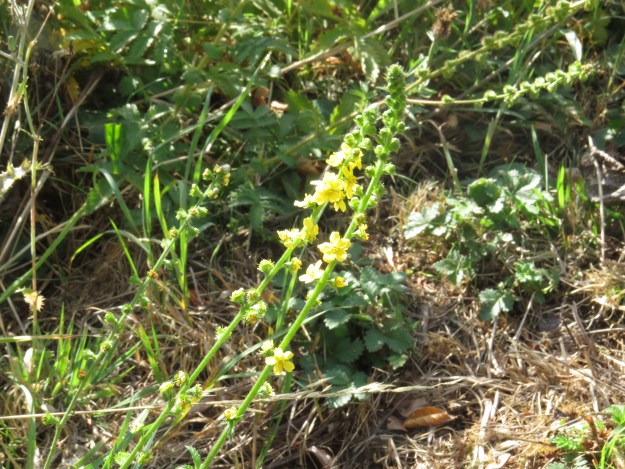
Agrimony (Agrimonia eupatoria)
Dear Readers, when I was visiting Mum and Dad’s grave last week I came across this lovely plant with its tiny yellow flowers. Meet Agrimony, a member of the rose family and a plant that favours chalky soils, which is probably why I never see it in East Finchley. It has long spikes of yellow flowers, and this plant was one of the last to still be in bloom, with most of the rest now just bearing splendid seedheads. One of the vernacular names for the plant is ‘Church Steeples’, because of the shape of the flower spikes, which also explains ‘Fairy Wand’ and ‘Aaron’s Rod’. I suspect that its golden colour has a lot to do with the name ‘Money In Both Pockets’.

The foliage is said to be mildly fragrant but that of the plant’s close relative Fragrant Agrimony(Agrimonia procera) is said to be very perfumed, as the name suggests. Fragrant Agrimony doesn’t like chalky soils, so it’s interesting to see how two very similar plants have divvied up the ecosystem. It reminds me of the way that Great Tits and Blue Tits, very similar small birds, can use the same tree because the former feed closer to the trunk, while the latter can take advantage of the smallest twigs because they’re marginally lighter.
The name ‘agrimony’ is said to come from the Greek word for poppy, which puzzled me for a bit – the plant doesn’t look like a poppy. However, it has had a folklore reputation as a sedative (and we all know about opium poppies) – it was said that if a sprig of Agrimony was placed under a person’s head, he or she would sleep until it was removed. The plant could also be brewed to make ‘arquebusade water’ which could cure musket wounds, and ward off witchcraft.
The seedheads are covered in hooks, rather like burrs, which cling to the fur of animals and are easily distributed around the countryside by passing foxes and golden retrievers. This gives rise to yet another local name, Sweethearts.

Agrimony seedheads (Photo One)
According to the indispensable Mrs Grieve’s Herbal, Agrimony produces a yellow dye, pale in September, darker later in the year. She also explains many of the medicinal uses of the plant. For internal haemorrhages, medieval medics recommended mixing the plant with pounded frogs and human blood. More recently, it was seen as being of great use in liver and gall-bladder complaints, skin conditions and gout. The plant also attracted the attention of Pliny the Elder, who believed that it could be useful for both preventing and treating snake bites. It is also said to be great for tired feet, so it’s just what I need after a trot around the Capital Ring. It was also used as an Anglo-Saxon sex aid: boiled in water, it would reduce lust, but if boiled in milk it would increase it. It just goes to show that a glass of warm milk before bedtime might not necessarily be relaxing.
Agrimony was a much commoner plant in the past, and one with such a variety of uses that many people will have known it. However, it is vulnerable to early mowing – its seed is set very late in the year, and so if an area is mown to early the seeds will not yet be ripe. This is a shame because Agrimony is favoured by many insects, including the Grizzled Skipper, whose caterpillars like agrimony and other small members of the rose family, such as wild strawberry and cinquefoil.

Grizzled skipper (Pyrgus malvae) (Photo Two)
And so, a poem. In the Language of Flowers, Agrimony stands for thankfulness, and I like this work by Christina M.Ward from 2019. I remember how, when I’ve been confronted with the great challenges of life, such as the death of a parent, I’ve felt myself slow down and soften, as if I’ve shed a skin. This poem captures some of that feelng.
Agrimonia (a free verse poem) by Christina M.Ward
I have gathered church steeples,
racemes of yellow Agrimonia,
as many as I can carry
It is not enough, I think
The butterflies and sun
follow me. We leave a
tender trail,
thankfulness, our meditation
I slide the ends under
cool waters, nip the ends
stems clogging the drain
You stir in your sleep,
a gasp, a wheeze
I am filled with hope, for you
for these —may their radiance
inspire your lungs to lift
searching the air for oxygen
as your eyes search for yellow
thankful, one more day

“thankful, one more day” … that is so 🙂
Phew, another snake bite cure! That is a cheery plant.
You can never have too many snake bite cures 🙂